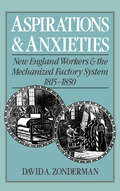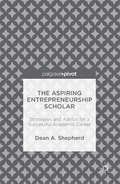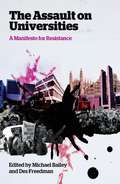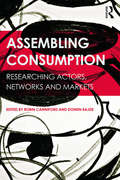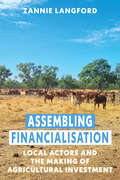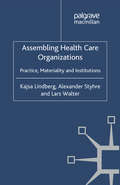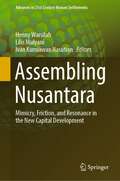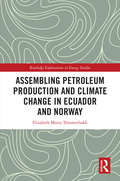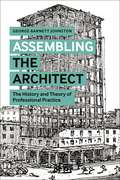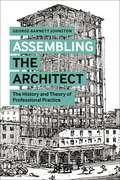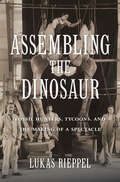- Table View
- List View
An Aspie’s Guide to Choosing a Career: Been There. Done That. Try This!
by Craig Evans Anita Lesko Tony AttwoodChoosing the right career is a key daily stressor for people with Asperger's Syndrome and this ebook is packed with advice from Aspie mentors who have all been there, done that, and offer career guidance that really work. Lars Perner, Anita Lesko, Debbie Denenburg, and more offer guidance based on their personal experiences of choosing a career and the ebook ends with professional analysis and recommendations from world expert Dr. Tony Attwood. This inspirational advice comes from the bestselling book Been There. Done That. Try This!, written by Aspies for Aspies, now available in short Aspie Mentor Guides!
An Aspie’s Guide to Choosing a Career: Been There. Done That. Try This! (PDF)
by Anita Lesko Craig Evans Tony AttwoodChoosing the right career is a key daily stressor for people with Asperger's Syndrome and this ebook is packed with advice from Aspie mentors who have all been there, done that, and offer career guidance that really work. Lars Perner, Anita Lesko, Debbie Denenburg, and more offer guidance based on their personal experiences of choosing a career and the ebook ends with professional analysis and recommendations from world expert Dr. Tony Attwood. This inspirational advice comes from the bestselling book Been There. Done That. Try This!, written by Aspies for Aspies, now available in short Aspie Mentor Guides!
An Aspie’s Guide to Getting and Keeping a Job: Been There. Done That. Try This!
by Craig Evans Anita Lesko Tony AttwoodGetting and keeping a job is a key daily stressor for people with Asperger's Syndrome and this ebook is packed with advice from Aspie mentors who have all been there, done that, and offer suggestions for employment strategies that really work. Temple Grandin, Richard Maguire, Anita Lesko and more offer guidance based on their personal jobhunting and employment experiences and the ebook ends with professional analysis and recommendations from world expert Dr. Tony Attwood. This inspirational advice comes from the bestselling book Been There. Done That. Try This!, written by Aspies for Aspies, now available in short Aspie Mentor Guides!
An Aspie’s Guide to Getting and Keeping a Job: Been There. Done That. Try This! (PDF)
by Anita Lesko Craig Evans Tony AttwoodGetting and keeping a job is a key daily stressor for people with Asperger's Syndrome and this ebook is packed with advice from Aspie mentors who have all been there, done that, and offer suggestions for employment strategies that really work. Temple Grandin, Richard Maguire, Anita Lesko and more offer guidance based on their personal jobhunting and employment experiences and the ebook ends with professional analysis and recommendations from world expert Dr. Tony Attwood. This inspirational advice comes from the bestselling book Been There. Done That. Try This!, written by Aspies for Aspies, now available in short Aspie Mentor Guides!
Aspiration Based Decision Support Systems: Theory, Software and Applications (Lecture Notes in Economics and Mathematical Systems #331)
by Andrzej Lewandowski Andrzej P. WierzbickiIt is not easy to summarize -even in a volume -the results of a scientific study con ducted by circa 30 researchers, in four different research institutions, though cooperating between them and jointly with the International Institute for Applied Systems Analysis, but working part-time, sponsored not only by IIASA's national currency funds, but also by several other research grants in Poland. The aims of this cooperative study were de fined broadly by its title Theory, Software and Testing Examples for Decision Support Systems. The focusing theme was the methodology of decision analysis and support related to the principle of reference point optimization (developed by the editors of this volume and called also variously: aspiration-led decision support, quasi-satisfying framework of rationality, DIDAS methodology etc. ). This focusing theme motivated extensive theoretical research - from basic methodological issues of decision analysis, through various results in mathematical programming (in the fields of large scale and stochastic optimization, nondifferentiable optimization, cooperative game theory) mo tivated and needed because of this theme, through methodological issues related to software development to issues resulting from testing and applications. We could not include in this volume all papers -theoretical, methodological, appiied, software manu als and documentation -written during this cooperative study.
Aspirational Revolution: The Purpose-Driven Economy
by Michael TaillardThis book illustrates how global economic progress has reached its upper limit under the current economic paradigm, and how the next major revolution in global progress will rely on our ability to tap into the collective knowledge of the “everyday genius” to drive innovation, free market competition, artistic influence, and other advances that will allow humanity to overcome its greatest challenges. This volume proposes a grant-based program that will allow innovators to pursue their passions and benefit society as a whole. Such a program will reflect the end of the industrial age, when technology is satisfying many basic needs and creating space for individuals to pursue meaningful, fulfilling careers with the potential to improve our quality of life. Our current economic state mirrors the beginnings of the Agricultural Revolution and Industrial Revolution, and Aspirational Revolution shows how the immediate future will redefine what it means to be human by revolutionizing the manner in which we acquire and utilize the resources necessary for our continued survival. This book is the catalyst by which this transition will occur, providing the models upon which new paradigms will be built – a brand new conception of fundamental economic theory.
Aspirations And Anxieties: New England Workers And The Mechanized Factory System, 1815-1850
by David A. ZondermanAspirations and Anxietiesis a working class intellectual history of early factory operatives in antebellum New England. The book focuses on the operatives' perceptions of technological and socio-economic changes in the mechanized workplace. The study uncovers a complex debate over many facets of the factory system--the machines and factory buildings, wages and hours, relations between managers and workers, and the content and character of protest. Finally, the book argues that the roots of this debate lie in the struggle to define the meaning of work itself in a period of profound social change.
The Aspiring CIO and CISO: A career guide to developing leadership skills, knowledge, experience, and behavior
by David J. GeeStrategically build your brand, master soft skills, and craft a powerful plan, propelling yourself into the dynamic world of executive leadership in the digital technology and cybersecurity domain Key FeaturesDiscover a targeted 90-day plan to set yourself up for success in both CIO and CISO rolesDevelop essential interpersonal skills to succeed in executive leadership rolesLearn survival skills for thriving and avoiding burnout in strategic rolesPurchase of the print or Kindle book includes a free PDF eBookBook DescriptionExplore the intricacies of CIO and CISO roles with The Aspiring CIO and CISO by David Gee. This book leverages Gee's 20+ years of digital and cyber leadership experience, providing real-world insights, making it a valuable resource for those navigating the evolving landscape of the C-suite. Tailored to entry-level, mid-level, and senior managers looking to advance to the C-suite, this book serves a unique purpose in the realm of career guidance. The narrative speaks directly to individuals uncertain about their readiness for CIO or CISO roles, offering a personal mentorship experience that goes beyond technicalities. Armed with insights into crafting a powerful 90-day plan, you'll be well-equipped to catapult into CIO or CISO roles successfully. Beyond technical proficiency, the book instills survival skills, ensuring longevity and helping you prevent burnout in these pivotal positions. Additionally, by mastering the art of brand development and soft skills, you'll grasp the interpersonal dynamics crucial for executive leadership. This book is an indispensable guide for ambitious professionals, offering foresight and empowerment to thrive in the digital age. By the end of this book, you'll emerge with strategic dexterity, confidently steering your career trajectory towards the C-suite.What you will learnDevelop a compelling personal brand for CIO and CISO rolesGain mentorship through expert tips, techniques, and proven strategies to navigate executive leadershipBe well prepared for interviews, with insights into interview questions as well as questions you can askGain insights into managing high-stakes situations and leading your organization through crisesPractice leadership through real-life CISO and CIO scenariosFind out how to establish and leverage professional networks crucial for your advancement to CIO or CISO rolesWho this book is forThis book is for entry-level, mid-level, and senior managers aspiring to ascend to the C-suite as CISOs or CIOs. The book is also aimed at IT and security professionals who want to gain the skills, knowledge, and experience to take on senior executive roles in the digital age.
The Aspiring Entrepreneurship Scholar: Strategies and Advice for a Successful Academic Career
by Dean A. ShepherdThis book offers helpful insight and advice on how doctoral students and junior faculty can succeed as an entrepreneurship scholar. It invites them to think entrepreneurially to identify research opportunities, manage the publication process, achieve excellence in the classroom, secure a faculty position, and build a research record worthy of promotion and tenure. Drawing from his experience as a research scholar, editor, review board member, mentor, and reviewer of many promotion and tenure cases, author Dean Shepherd offers strategies and other pieces of advice for navigating the obstacles that can prevent a successful scholarly career.This book provides an overview and roadmap to help entrepreneurship scholars achieve success, and stimulates thought and discussion for doctoral students and junior and senior faculty to consider as they look to develop the next generation in academia.
The Assault on Universities: A Manifesto for Resistance
by Michael Bailey Des FreedmanWith funding cuts well under way and many institutions already promising to charge the maximum 9,000 pounds yearly tuition fee, university education for the majority is under threat. This book exposes the true motives behind the government's programme and provides the analytical tools to fight it.*BR**BR*Widespread student protests and occupations, often supported by staff, unions and society at large, show the public's opposition to funding cuts and fee increases. The contributors to this sharp, well-written collection, many of whom are active participants in the anti-cuts movement, outline what's at stake and why it matters. They argue that university education is becoming increasingly skewed towards vocational degrees, which devalues the arts and social sciences - subjects that allow creativity and political inquiry to flourish.*BR**BR*Released at the beginning of the new academic year, this book will be at the heart of debates around the future of higher education in the UK and beyond, inspiring both new and seasoned activists in the fight for the soul of our universities.
The Assault on Universities: A Manifesto for Resistance
by Des Freedman Michael BaileyWith funding cuts well under way and many institutions already promising to charge the maximum 9,000 pounds yearly tuition fee, university education for the majority is under threat. This book exposes the true motives behind the government's programme and provides the analytical tools to fight it.*BR**BR*Widespread student protests and occupations, often supported by staff, unions and society at large, show the public's opposition to funding cuts and fee increases. The contributors to this sharp, well-written collection, many of whom are active participants in the anti-cuts movement, outline what's at stake and why it matters. They argue that university education is becoming increasingly skewed towards vocational degrees, which devalues the arts and social sciences - subjects that allow creativity and political inquiry to flourish.*BR**BR*Released at the beginning of the new academic year, this book will be at the heart of debates around the future of higher education in the UK and beyond, inspiring both new and seasoned activists in the fight for the soul of our universities.
Assekuranz, Ökologie und Risiko: Versicherungen als Mitgestalter des ökologischen Generationenvertrages (DUV Wirtschaftswissenschaft)
by Reiner WiedenlübbertDer Autor untersucht das Spannungsdreieck von Assekuranz, Ökologie und Risiko und kommt zu dem Ergebnis, dass die Versicherungswirtschaft den "ökologischen Generationenvertrag" aktiv mitgestalten sollte.
Assembling Consumption: Researching actors, networks and markets
by Domen Bajde Robin CannifordAssembling Consumption marks a definitive step in the institutionalisation of qualitative business research. By gathering leading scholars and educators who study markets, marketing and consumption through the lenses of philosophy, sociology and anthropology, this book clarifies and applies the investigative tools offered by assemblage theory, actor-network theory and non-representational theory. Clear theoretical explanation and methodological innovation, alongside empirical applications of these emerging frameworks will offer readers new and refreshing perspectives on consumer culture and market societies. This is an essential reading for both seasoned scholars and advanced students of markets, economies and social forms of consumption.
Assembling Consumption: Researching actors, networks and markets
by Domen Bajde Robin CannifordAssembling Consumption marks a definitive step in the institutionalisation of qualitative business research. By gathering leading scholars and educators who study markets, marketing and consumption through the lenses of philosophy, sociology and anthropology, this book clarifies and applies the investigative tools offered by assemblage theory, actor-network theory and non-representational theory. Clear theoretical explanation and methodological innovation, alongside empirical applications of these emerging frameworks will offer readers new and refreshing perspectives on consumer culture and market societies. This is an essential reading for both seasoned scholars and advanced students of markets, economies and social forms of consumption.
Assembling Financialisation: Local Actors and the Making of Agricultural Investment
by Zannie LangfordFarmers, Indigenous organisations, government and private-sector intermediaries from remote Northern Australia often negotiate with private finance capital to gain funds for agricultural development.The concept of financialisation is used to explore the drivers and effects of agrifood restructuring in the area, while assemblage theory is applied to position local actors as potential sites of power in negotiating connections between local spaces and global finance. This book demonstrates that while financialisation is a useful signifier of patterns of global change, it is assembled by a diverse range of often contradictory work.
Assembling Financialisation: Local Actors and the Making of Agricultural Investment
by Zannie LangfordFarmers, Indigenous organisations, government and private-sector intermediaries from remote Northern Australia often negotiate with private finance capital to gain funds for agricultural development.The concept of financialisation is used to explore the drivers and effects of agrifood restructuring in the area, while assemblage theory is applied to position local actors as potential sites of power in negotiating connections between local spaces and global finance. This book demonstrates that while financialisation is a useful signifier of patterns of global change, it is assembled by a diverse range of often contradictory work.
Assembling Financialisation: Local Actors and the Making of Agricultural Investment
by Zannie LangfordFarmers, Indigenous organisations, government and private-sector intermediaries from remote Northern Australia often negotiate with private finance capital to gain funds for agricultural development.The concept of financialisation is used to explore the drivers and effects of agrifood restructuring in the area, while assemblage theory is applied to position local actors as potential sites of power in negotiating connections between local spaces and global finance. This book demonstrates that while financialisation is a useful signifier of patterns of global change, it is assembled by a diverse range of often contradictory work.
Assembling Health Care Organizations: Practice, Materiality and Institutions
by K. Lindberg A. Styhre Lars WalterAssembling Health Care Organizations combines an institutional theory perspective with a materialist view of the technologies, devices, biological specimens, and other material resources mobilized and put to work in health care work.
Assembling Nusantara: Mimicry, Friction, and Resonance in the New Capital Development (Advances in 21st Century Human Settlements)
by Lilis Mulyani Henny Warsilah Ivan Kurniawan NasutionToday, the new Indonesian capital city, Nusantara, planning is being anticipated as “representing national identity,” “a model city,” or “a gift to the world,” and many other extraordinary labels. This book examines the reality of an ongoing developmental transformation of the Nusantara beyond those labels. It approaches its assemblage of humans, their works (plans, documents, policies, and others), non-human objects (biodiversity, landscape, geography, physical infrastructure, buildings, and public spaces), processes, social relationships, social infrastructures, and others. It is organized into three themes—mimicry, friction, and resonance. The mimicry illustrates the similarities (and differences) between Nusantara and other capital cities in urban narratives, imageries, and forms. The friction studies how Nusantara moves actors who do not always agree, processes that do not always align or collaboration between diverse contradicting groups that intersect. The resonance observes how Nusantara resonates with, yet communicates its voice toward, the world. The three concepts (originated from geography, anthropology, and sociology) frame the analytics of the various contributions of local and foreign scientists from multiple disciplines. Overall, the book recommends “Otorita Ibu Kota Nusantara” (Nusantara capital city authority) on the current experimentation and implementation of the urban vision and provides a reference for social scientists to study Nusantara. And more broadly, the book offers the current socio-spatial practices of capital city-making in Asia that are valuable for the region.
Assembling Petroleum Production and Climate Change in Ecuador and Norway (Routledge Explorations in Energy Studies)
by Elisabeth Marta TómmerbakkThis book addresses some of the controversies and uncertainties associated with reducing the extensive exploitation of fossil fuels due to their role in global warming. Elisabeth Marta Tómmerbakk explores why a transition towards a post-carbon society is so difficult to accomplish by examining how the relationship between petroleum production and climate change is politically framed and negotiated in contested cases. This question is approached through a process-oriented comparative case study of Lofoten, located in the Norwegian Sea above the Arctic Circle, and Yasuní-ITT (Ishpingo, Tambococha, and Tiputini) located in the Ecuadorian Amazon: regions that both belong to oil-exporting countries with highly oil-dependent economies. Tómmerbakk draws on rich empirical data that includes qualitative interviews with subjects in both countries and applies an Actor-Network Theory framework to show that oil and climate are intricately entangled in knowledge and policy practices. Overall, Assembling Petroleum Production and Climate Change in Ecuador and Norway provides an in-depth examination of how climate science and petroleum extraction are negotiated, adapted, assembled, and coordinated with other national policies and political aims. This book will be of great interest to students and scholars of petroleum production, climate change, environmental policy, and environmental sociology.
Assembling Petroleum Production and Climate Change in Ecuador and Norway (Routledge Explorations in Energy Studies)
by Elisabeth Marta TómmerbakkThis book addresses some of the controversies and uncertainties associated with reducing the extensive exploitation of fossil fuels due to their role in global warming. Elisabeth Marta Tómmerbakk explores why a transition towards a post-carbon society is so difficult to accomplish by examining how the relationship between petroleum production and climate change is politically framed and negotiated in contested cases. This question is approached through a process-oriented comparative case study of Lofoten, located in the Norwegian Sea above the Arctic Circle, and Yasuní-ITT (Ishpingo, Tambococha, and Tiputini) located in the Ecuadorian Amazon: regions that both belong to oil-exporting countries with highly oil-dependent economies. Tómmerbakk draws on rich empirical data that includes qualitative interviews with subjects in both countries and applies an Actor-Network Theory framework to show that oil and climate are intricately entangled in knowledge and policy practices. Overall, Assembling Petroleum Production and Climate Change in Ecuador and Norway provides an in-depth examination of how climate science and petroleum extraction are negotiated, adapted, assembled, and coordinated with other national policies and political aims. This book will be of great interest to students and scholars of petroleum production, climate change, environmental policy, and environmental sociology.
Assembling the Architect: The History and Theory of Professional Practice
by George Barnett JohnstonAssembling the Architect explores the origins and history of architectural practice. It unravels the competing interests that historically have structured the field and cultivates a deeper understanding of the contemporary profession.Focusing on the period 1870 to 1920 when the foundations were being laid for the U.S. architectural profession that we recognize today, this study traces the formation and standardization of the fundamental relationships among architects, owners, and builders, as codified in the American Institute of Architects' very first Handbook of Architectural Practice. It reveals how these archetypal roles have always been fluid, each successfully redefining their own agency with respect to the others in the constantly-shifting political economy of building.Far from being a purely historical study, the book also sheds light on today's digitally-enabled profession. Contemporary architectural tools and disciplinary ideals continue to be shaped by the same fundamental tensions, and emergent modes of practice such as BIM (Building Information Modelling) and IPD (Integrated Project Delivery) represent the realization of programs and agendas that have been over a century in play.Essential reading for professional practice courses as a contextual and historical companion to the Handbook, Assembling the Architect provides a critical perspective of the profession that is fundamental to understanding current architectural practice.
Assembling the Architect: The History and Theory of Professional Practice
by George Barnett JohnstonAssembling the Architect explores the origins and history of architectural practice. It unravels the competing interests that historically have structured the field and cultivates a deeper understanding of the contemporary profession.Focusing on the period 1870 to 1920 when the foundations were being laid for the U.S. architectural profession that we recognize today, this study traces the formation and standardization of the fundamental relationships among architects, owners, and builders, as codified in the American Institute of Architects' very first Handbook of Architectural Practice. It reveals how these archetypal roles have always been fluid, each successfully redefining their own agency with respect to the others in the constantly-shifting political economy of building.Far from being a purely historical study, the book also sheds light on today's digitally-enabled profession. Contemporary architectural tools and disciplinary ideals continue to be shaped by the same fundamental tensions, and emergent modes of practice such as BIM (Building Information Modelling) and IPD (Integrated Project Delivery) represent the realization of programs and agendas that have been over a century in play.Essential reading for professional practice courses as a contextual and historical companion to the Handbook, Assembling the Architect provides a critical perspective of the profession that is fundamental to understanding current architectural practice.
Assembling the Dinosaur: Fossil Hunters, Tycoons, and the Making of a Spectacle
by Lukas RieppelLukas Rieppel shows how dinosaurs gripped the popular imagination and became emblems of America’s industrial power and economic prosperity during the Gilded Age. Spectacular fossils were displayed in museums financed by North America’s wealthiest tycoons, to cement their reputation as both benefactors of science and fierce capitalists.
Assembly-Line Balancing under Demand Uncertainty (Gabler Theses)
by Celso Gustavo Stall SikoraAssembly lines are productive systems, which are very efficient for homogeneous products. In the automotive industry, an assembly line is used in the production of several vehicle variants, including numerous configurations, options, and add-ins. As a result, assembly lines must be at the same time specialized to provide high efficiency, but also flexible to allow the mass customization of the vehicles. In this book, the planning of assembly lines for uncertain demand is tackled and optimization algorithms are offered for the balancing of such lines. Building an assembly line is a commitment of several months or even years, it is understandable that the demand will fluctuate during the lifetime of an assembly line. New products are developed, others are removed from the market, and the decision of the final customer plays a role on the immediate demand. Therefore, the variation and uncertainty of the demand must be accounted for in an assembly line. In this book, methods dealing with random demand or random production sequence are presented, so that the practitioners can plan more robust and efficient production systems.




